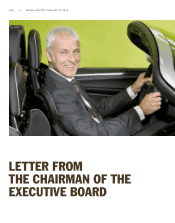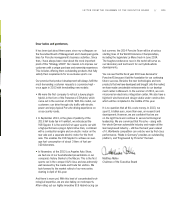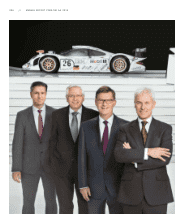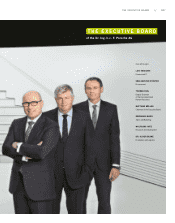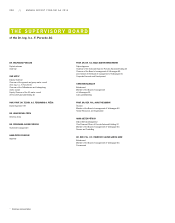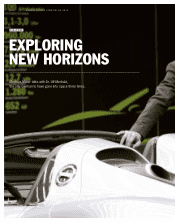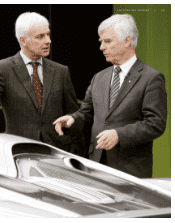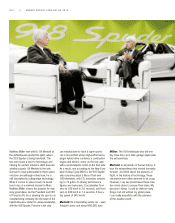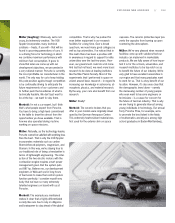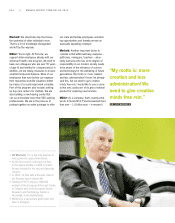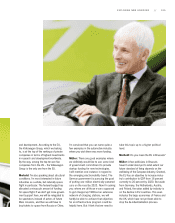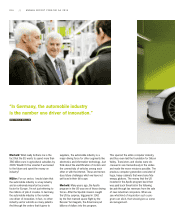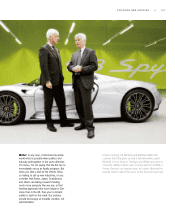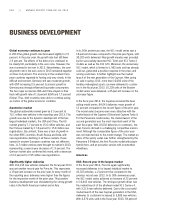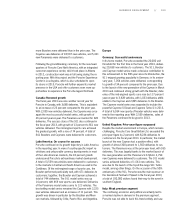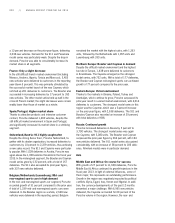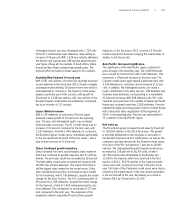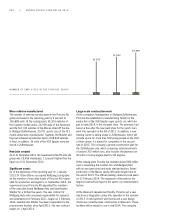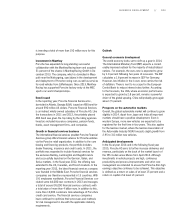Porsche 2013 Annual Report Download - page 15
Download and view the complete annual report
Please find page 15 of the 2013 Porsche annual report below. You can navigate through the pages in the report by either clicking on the pages listed below, or by using the keyword search tool below to find specific information within the annual report.
Müller (laughing): Obviously, we’re not
crazy, but extremely creative. The 918
Spyder incorporates many technical
solutions – treats, if you will – that will be
found in upcoming generations of cars. It
is a driving force for technology in which
we combine maximum performance with
minimum fuel consumption. It goes to
show that when we came up with our
development objectives, we proceeded in
a very rational manner. Porsche is currently
the most profitable car manufacturer in the
world. The only way for us to keep holding
this pole position against tough competition
is by continually striving to anticipate the
future requirements of our customers and
to further push the boundaries of what is
technically feasible. We don’t just want to
be at the top – we want to stay there.
Merbold: I’m not a car expert, but I think
that’s what people expect from Porsche.
You have to bring a high level commitment
to the table to draw the utmost from the
opportunities you have available. That is
how we also operated during my time
working on space missions.
Müller: Naturally, as the technology leader,
Porsche cannot be satisfied with anything less
than the best. That is why the 918 Spyder
incorporates materials such as carbon
fiber-reinforced polymers, magnesium, and
titanium. In this way, we’re staying true to
our traditional role of being a trendsetter in
terms of lightweight engineering. The inter-
action of the two electric motors with the
combustion engine requires smart power
management given that the system puts
out 887 hp. Believe me, our development
engineers in Weissach put in long hours
of hard work to make that control system
function perfectly. I consider myself very
lucky that we have so many extremely
talented engineers on board with us at
Porsche.
Merbold: The example you mentioned
makes it clear that a highly differentiated
society like ours has to rely on diligence
and brainpower to stay ahead of the global
competition. That is why I’ve pushed for
even better equipment in our research
facilities for a long time. Over a broad
spectrum, we need many good colleges as
well as top universities. I’ve noticed that in
this realm there has been a positive shift
in awareness in regard to support for elite
universities over the last few years. How-
ever, our government could do a lot more.
And last but not least, we need more basic
research to be done at leading institutes
like the Max Planck Society. Most of the
experiments that I performed in space re-
volved around basic research – in regard to
increasing our knowledge in astronomy, at-
mospheric physics, and material research.
By the way, your cars also benefit from our
research.
Müller: Really?
Merbold: The ceramic brakes that you
offer in your models were originally devel-
oped by the German Aerospace Center.
This extremely heat-resistant material was
first used for the exterior skin on space
capsules. The ceramic protective layer pre-
vents the capsules from burning up upon
re-entering the atmosphere.
Müller: We’re very pleased when research
facilities come up with solutions that our
industry can implement in marketable
products. We are fully aware of how impor-
tant it is for the schools, universities, and
research institutes to be top-notch so as
to benefit the future of our industry. We’re
very glad to have excellent universities in
our region and that many graduates want
to work for us. That is a key benefit of our
location. However, it’s also very clear that
the demographic trend alone – namely
the decreasing number of young people
who even want to become engineers or
technicians – is a cause for concern for
the future of German industry. That is why
we are trying to generate interest among
young individuals in technology. Our annual
Ferry Porsche Prize, for example, aims
to promote the best talent in the fields
of mathematics and physics among high
school graduates in Baden-Württemberg.
EXPLORING NEW HORIZONS // 013



